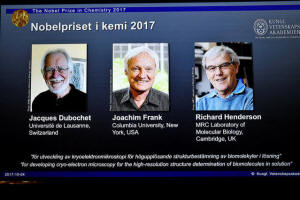|
Microscope trailblazers win 2017 Nobel
Chemistry Prize
 Send a link to a friend
Send a link to a friend
 [October 04, 2017]
STOCKHOLM (Reuters) - Scientists
Jacques Dubochet, Joachim Frank and Richard Henderson won the 2017 Nobel
Prize for Chemistry on Wednesday for developing cryo-electron microscopy
which simplifies and improves the imaging of biomolecules. [October 04, 2017]
STOCKHOLM (Reuters) - Scientists
Jacques Dubochet, Joachim Frank and Richard Henderson won the 2017 Nobel
Prize for Chemistry on Wednesday for developing cryo-electron microscopy
which simplifies and improves the imaging of biomolecules.
Cryo-electron microscopy has enabled scientists to fill in previously
blank spaces in research, generating images of everything from proteins
that cause antibiotic resistance, to the surface of the Zika virus.
"This method has moved biochemistry into a new era," the Royal Swedish
Academy of Sciences, which awards Nobel prizes, said in a statement. The
awarding brings a 9 million Swedish crown ($1.1 million) prize.
"Researchers can now freeze biomolecules mid-movement and visualize
processes they have never previously seen, which is decisive for both
the basic understanding of life's chemistry and for the development of
pharmaceuticals."

Scottish-born scientist Henderson used an electron microscope to
generate a three-dimensional image of a protein at an atomic resolution,
showing the potential of the technology.
His breakthrough was further developed by German-born scientist Frank
while Dubochet of Switzerland used rapidly frozen water to preserve the
natural shape of the biomolecules.
Chemistry is the third of this year's Nobel Prizes after the winners of
the medicine and physics prizes were announced earlier this week.
The prizes are named after Alfred Nobel, the inventor of dynamite, and
have been awarded since 1901 for achievements in science, literature and
peace, in accordance with his will.
[to top of second column] |

The names of Jacques Dubochet, Joachim Frank and Richard Henderson
are displayed on the screen during the announcement of the winners
of the Nobel Prize in Chemistry 2017, in Stockholm, Sweden, October
4, 2017. TT News Agency/Claudio Bresciani via REUTERS

While the chemistry award has sometimes been overshadowed by the
towering reputations of physics winners such as Albert Einstein,
laureates include ground-breaking scientists such as radioactivity
pioneers Ernest Rutherford and Marie Curie, though she also won the
physics prize.
The award passed over one of the highest-profile fields of research,
the so-called CRISPR-Cas9 gene editing technology that earlier this
year allowed U.S. scientists to alter genes in a human embryo to
correct a disease-causing mutation.
(Reporting by Niklas Pollard and Simon Johnson; Additional reporting
by Anna Ringstrom, Johan Ahlander, Helena Soderpalm and Johannes
Hellstrom; editing by Justyna Pawlak/Jeremy Gaunt)
[© 2017 Thomson Reuters. All rights
reserved.]
Copyright 2017 Reuters. All rights reserved. This material may not be published,
broadcast, rewritten or redistributed.
 |